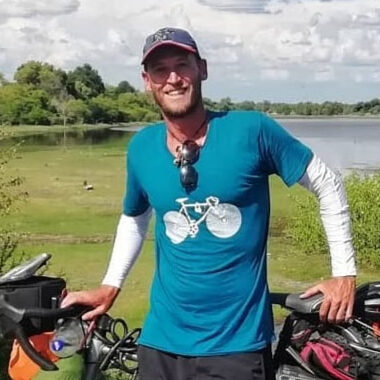Cairo to Cape Town Cycling Route: Interview with Mark Beaumont and Four Other Cycle Adventurers
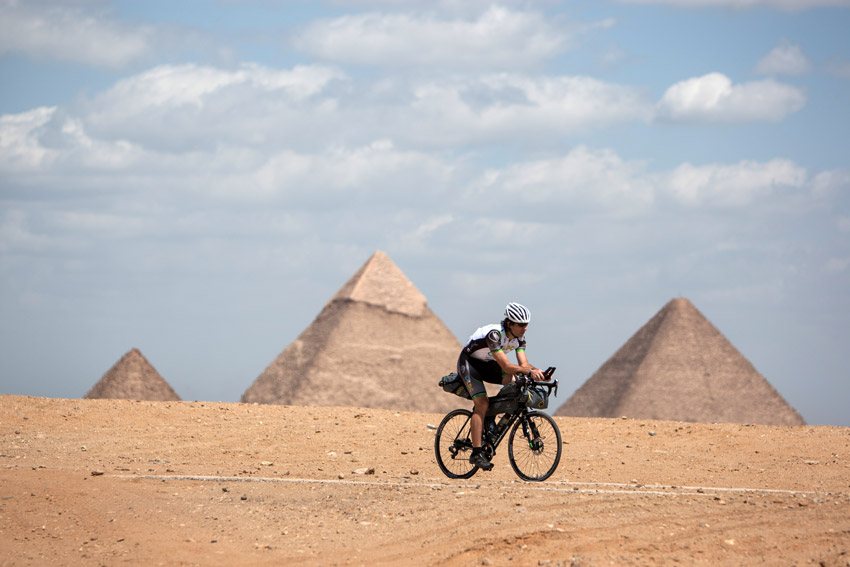
Photo courtesy of Mark Beaumont (Private Archive)
After traveling numerous routes and historic cycling paths, it’s common for bikepackers to decide to transverse Africa following a popular passage that starts in Cairo and ends in Cape Town (a less preferred route starts from Cape Town to Cairo but is full of headwinds).
The route crosses 14 magical countries that are full of a diverse eco-culture, people, landscapes, and endless places to explore. Bikepackers can stick to the coast or ride in land-locked regions, both offering a stunning adventure while biking in Africa.
We’ll be talking to Mark Beaumont, a world-renowned record-breaking cyclist, Andolfo Aldo, Eilidh Ogden, Emilie Poudroux, and Tristan Ridley about their experiences from cycling on the Cairo to Cape Town route.
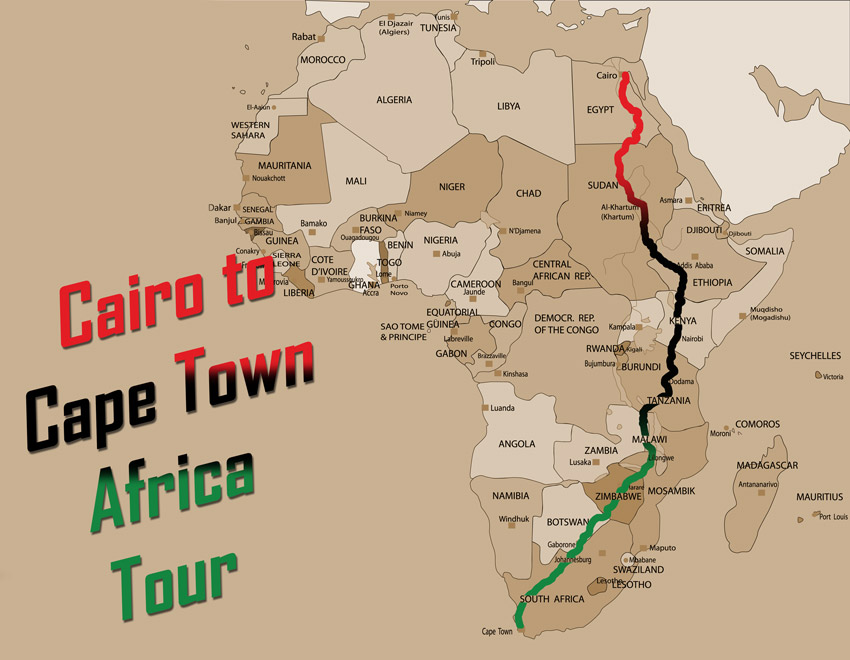
An example of a Cairo to Cape Town cycling route. Some cyclists also include Namibia by cycling east from Zimbabwe. (© Bikexchange.com)
The journey takes anywhere from two to nine months and is indeed an unforgettable experience. Experts recommend taking the longest possible span to enjoy every moment more.
The longer one ventures, the more they realize Africa is the promised land and they should have done it earlier. Visitors to Africa return home not only with memories, but often leave a piece of their heart behind with a promise to one day return—therefore considered the last frontier.
The most common routes from Cairo to Cape Town cover some or all of the following countries:
- Egypt
- Sudan
- South Sudan
- Ethiopia
- Uganda
- Rwanda
- Kenya
- Tanzania
- Malawi
- Zambia
- Botswana
- Zimbabwe
- Mozambique
- Namibia
- South Africa
Since border crossings in Africa are relatively easy to cross by bike, it’s viable to visit all these countries during your journey, although different visa requirements apply—depending on your nationality.
What makes the Cairo to Cape Town route so popular?
The route has acquired fame over the years as more and more bikepackers share their experiences with the bikepacking community and encourage others to explore it.
However, it’s not for the fainthearted as much of the route goes through untamed wilderness and there’s a high chance of interaction with wildlife.
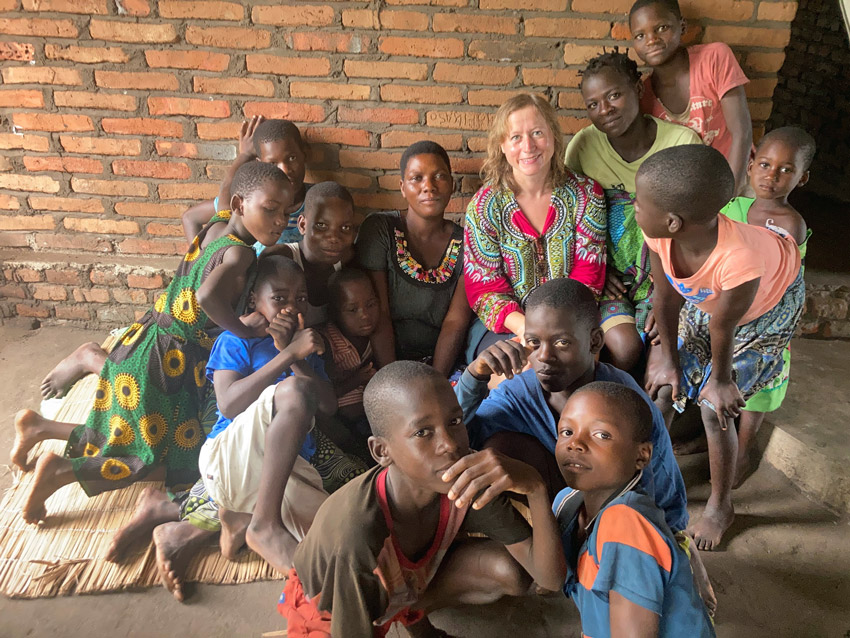
Most travelers mention the incredible people they meet along the way to be one of the main reasons the Cairo to Cape Town route is so special. (Photo courtesy of Eilidh Ogden)
The journey is truly an extraordinary expedition, full of exhilarating encounters—from wild camping in the bush to enjoying the food, language, and cultural differences of unknown territories and people.
The fastest person to travel from Cairo to Cape Town is Mark Beaumont, having done it in a jaw-dropping time of 41 days, 10 hours, and 22 minutes on a Koga road bike.
His achievement has raised popularity with other bikepackers and is making more competitive and non-competitive riders interested in the challenge.
Africa also offers unparalleled flora and fauna, serving as home to an expansive variety of animals and plants, many of which are rare and some, sadly, even close to extinction. The variation in the climate with each border crossing makes it an even more memorable experience for every visitor.
What challenges are involved when biking in Africa?
Africa offers breathtaking landscapes and unforgettable experiences but comes with numerous challenges and potential setbacks.
Here are six common issues to think about before embarking on a Cape to Cairo adventure and our recommendations on how to tackle them.
1. Visas and Vaccinations
The African continent is home to 54 countries, each one having its own specific rules and travel regulations. Every bikepacker has to research what the visa and vaccination requirements are from their country of citizenship or residence. While some nations offer them on arrival, others require an e-visa, with some requesting an interview at their local embassy.
Therefore, for smoother border crossings, it is recommended to have all required documentation in hand and up to date and keep checking for updates, especially with the pandemic still making border crossings more complicated worldwide.
2. Flying in and out of Africa
Flying into Cairo and out of Cape Town may not be an enormous challenge, as both airports host several international airlines with regular flights. However, each airline has its regulations for carrying bikes, so it’s advisable to check with them beforehand on what their recommendation is.
While most charge a small fee and require adequate packaging, some bikepackers have been denied boarding or forced to miss a flight because of miscommunication on the luggage restrictions.
3. Bike Parts, Water, Food & Medical Assistance
Locating components and roadside mechanics to tend to the bike is one of the biggest challenges, particularly given that performance bikes are uncommon.
Most parts that fail need to be sourced from big cities or the manufacturer directly, so it’s important to bring extra spares and specialist tools. However, even the most prepared cyclists eventually get tested on their bush mechanic skills. Therefore, make sure to learn how to do basic bike maintenance and the most common bike repairs before embarking on your trip.
The main thing to always have is a purifier or a filtration device to ensure your water is safe for drinking—Africa is known for tropical diseases like cholera and typhoid.
Food isn’t difficult to find in heavily populated areas but experts recommend planning ahead with adequate food for long, empty stretches between that have little or no human population.
Professional medical help may be a long distance away from where bikepackers are, so it’s advisable to discuss any health conditions with a practitioner and come prepared with medication—small precautions can be the deciding factor between life and death!
4. Bringing the Right Gear
Many African communities are nomadic pastoralists and are constantly on the move, so don’t always trust books or maps describing settlements in specific areas.
It’s recommended to bring adequate clothing and shelter for any conditions, as you may find yourself traveling long distances with no sign of civilization. Pack everything needed and carry it onboard, including rain jackets, sleeping bags, tents, chargers, cooking equipment, and food.
In many areas, it’s advisable to use safety devices such as chains and bike locks while wild camping.
Another important consideration is doing the trip on a high-quality bikepacking bike that’s designed to endure the challenges that the African continent will throw at it. This way, you will minimize the chances of having a severe breakdown that could bring an end to your adventure.
5. War and Community Conflict
It’s an unfortunate reality that many beautiful African countries struggle with ongoing wars and tension between communities. To keep tourists safe, travel guidelines are regularly updated and publicized by government agencies. It’s important to pay close attention to the latest recommendations as failure to observe them can have devastating consequences.
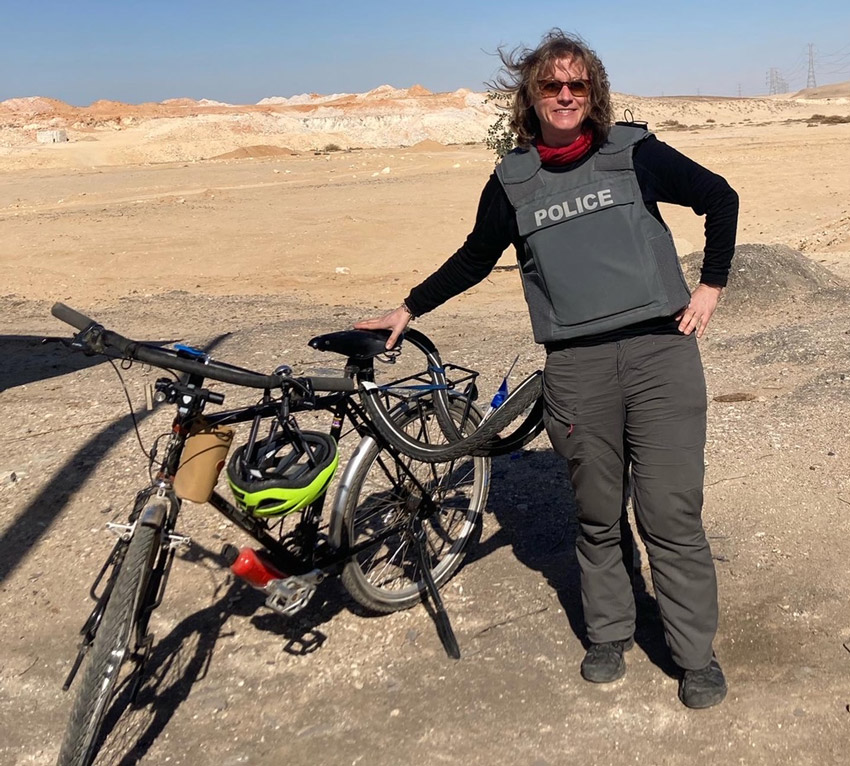
Police escort is mandatory for most bicycle travelers in Egypt due to safety concerns. (Photo courtesy of Eilidh Ogden)
Even in some otherwise ‘safe’ regions, foreigners are not considered welcome by local communities who have been known to torment them. In Ethiopia, for example, children are notorious for throwing stones at foreign cyclists, while others often stop them and demand money or gifts.
Additionally, female cyclists sometimes face troubles when traveling through Egypt, especially in remote areas and villages, due to prejudices some local communities hold. However, such unpleasantries are uncommon in urban areas and on well-established roads.
6. Payments and Sim Cards
Unlike the EU, Africa doesn’t have a single, shared currency, so it’s best to carry US dollars which are widely accepted and easily exchanged.
Visa cards are the most commonly accepted across Africa, followed by Mastercard. However, as much as cards are an uncomplicated way of making payments, they are rarely accepted everywhere, so always carry some hard cash as a backup.
Each nation has its own phone provider service and many have mobile payment systems that are contactless and don’t require a bank account—these are efficient and used by individuals and vendors. For example, Kenya has three providers—Safaricom, Airtel, and Telecom. Bikepackers recommend researching the best subscriber for data because the costs can vary and end up being expensive.
People who have conquered the Cairo to Cape Town route
We set out to find five individuals that have completed the Cairo to Cape Town bikepacking tour and asked them some questions to know more about their experience. Below is their profile and a firsthand record of their adventures, as well as some interesting or dangerous encounters with wildlife.
Mark Beaumont from Edinburgh
Mark is a world-renowned cyclist with many records under his belt. His name is one that comes up on the Cairo to Cape Town route often as he holds the record for doing it in the fastest time.
He also set the fastest time for cycling around the world and is seeking new challenges. Mark started cycling at the tender age of 12 and managed to go across Scotland, fuelling his passion for biking.
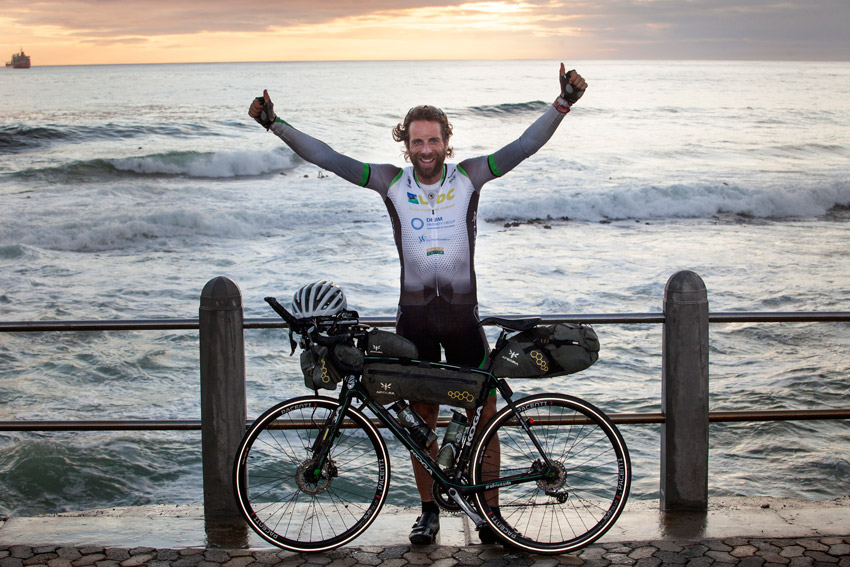
Mark Beaumont on arrival in Cape Town after crossing the route in record-breaking time. (Photo courtesy of Mark Beaumont)
He’s now a full-time adventurer and documentary maker with a dream to one day return to Africa. When asked if he wanted to come back, he said: “Absolutely. Cycling the length of Africa is still my favorite bike-packing adventure of all.”
To follow more of his adventures, he can be found on his Instagram @MrMarkBeaumont.
Andolfo Aldo from France
Aldo is an ex-ambulance driver who has been traveling around Europe, Asia, North America, and Africa for over 42 months.
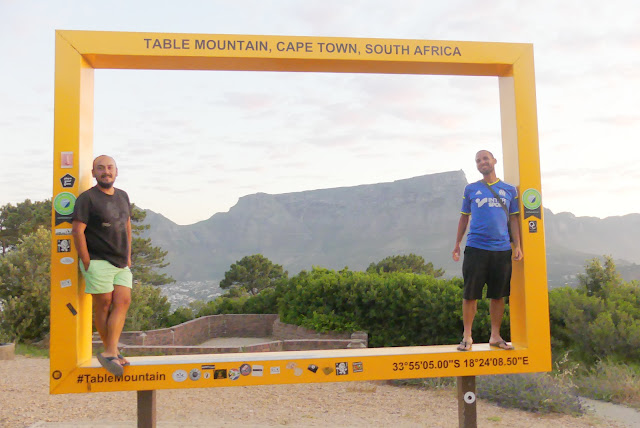
Andolfo Aldo (right) on top of Table Mountain above Cape Town. (Photo courtesy of Andolfo Aldo)
He started his travels in April 2016 after renouncing all his worldly possessions to go on his adventure.
Like Mark Beaumont, he also hopes to return and cycle the Cairo to Cape Town route again. Aldo runs a personal blog and can be reached on his Instagram @aldo_andolfo.
Eilidh Ogden from Scotland
Eilidh, a full-time civil servant based in London, challenged herself to cross Africa by bike in six months.
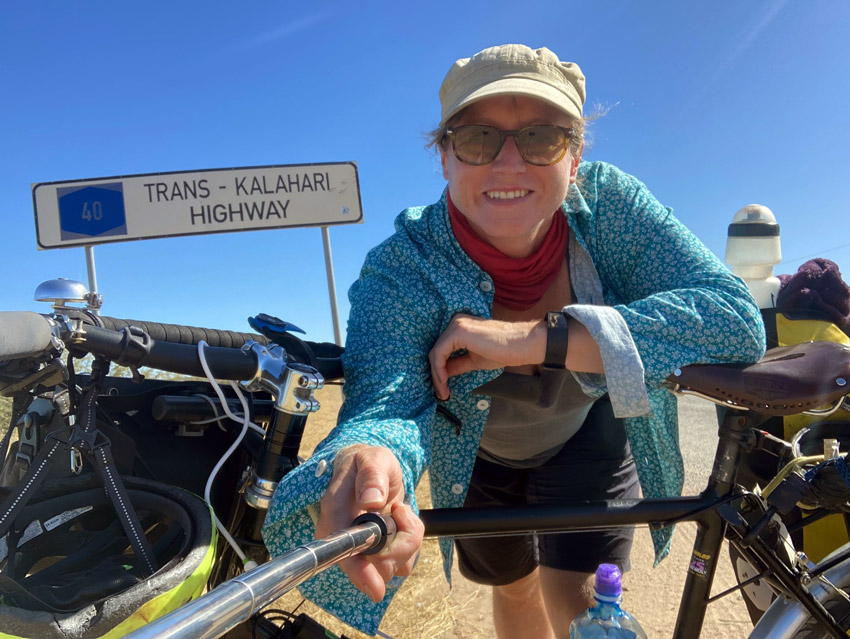
Eilidh Ogden on the Trans-Kalahari Highway in southern Africa. (Photo courtesy of Eilidh Ogden)
Although she cycles to get around and has been to various towns and cities on a bike, she had never undertaken such a challenge as this before. She started off her African odyssey in January 2022 with an open mind and very little planning.
You can read her personal blog here and you can follow her on Instagram @eilidhogden to stay up-to-date with her new adventures.
Emilie Poudroux from France
Emilie spends close to 6 months of the year working as a professional tour guide and is now in East Africa, giving tourists an unforgettable experience.
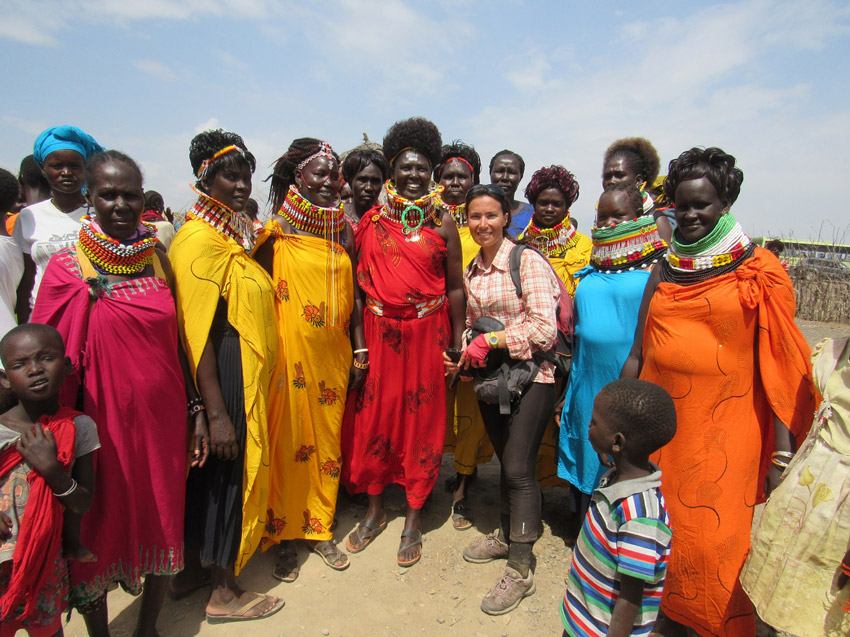
Emilie Poudroux at a traditional African wedding in Turkana, Kenya. (Photo courtesy of Emilie Poudroux)
After completing the Cairo to Cape route, she now plans to cycle West Africa starting in January 2023. Emilie has traveled to over 107 countries, 15 of which she did by bicycle, racking up a huge 18,000 km in the saddle.
She has covered all her experiences in her blog and on Instagram @emi.around.the.world.
Tristan Ridley from England
Tristan is a full-time writer and is bikepacking around the world with a goal of crossing 100 countries and 100,000 km across 6 continents.
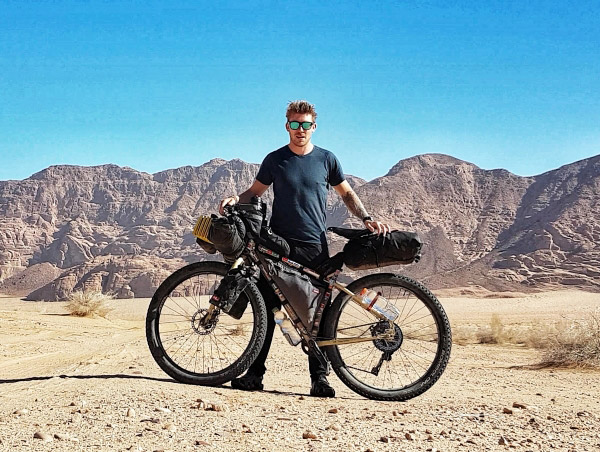
Tristan Ridley somewhere deep in Africa on his Cairo to Cape Town adventure. (Photo courtesy of Tristan Ridley)
He has clocked 66 nations since 2015 and has covered over 66,000 km under his wheels. His personal record of bikepacking nonstop is for an entire month in China and he completed 4700 km—that’s over 150 km a day!
He shares his experiences on his blog and is reachable on Instagram @tristanrid.
Exclusive Interviews for Bikexhange
We sat down to talk about their experiences while traversing Africa, so keep reading to learn about the challenges they faced, the unforgettable memories they made, and the unique encounters with people that made their African adventure special.
Special thanks to Tanvir Sabharwal from Kenya who conducted the interviews and contributed greatly to the realization of this article.
Q: Why did you decide to cycle from Cairo to Cape Town?
Mark: I have always wanted to complete what I see as the three ‘epic’ endurance cycles on the planet, which are the circumnavigation (of the world), the length of the Americas, and the length of Africa. In 2007/8 I cycled 18,000 miles around the World, in 2009/10 I cycled 13,000 miles from Alaska to Tierra del Fuego, and then for approximately five years, I got involved in other adventures—mainly ocean rowing and arctic documentaries.
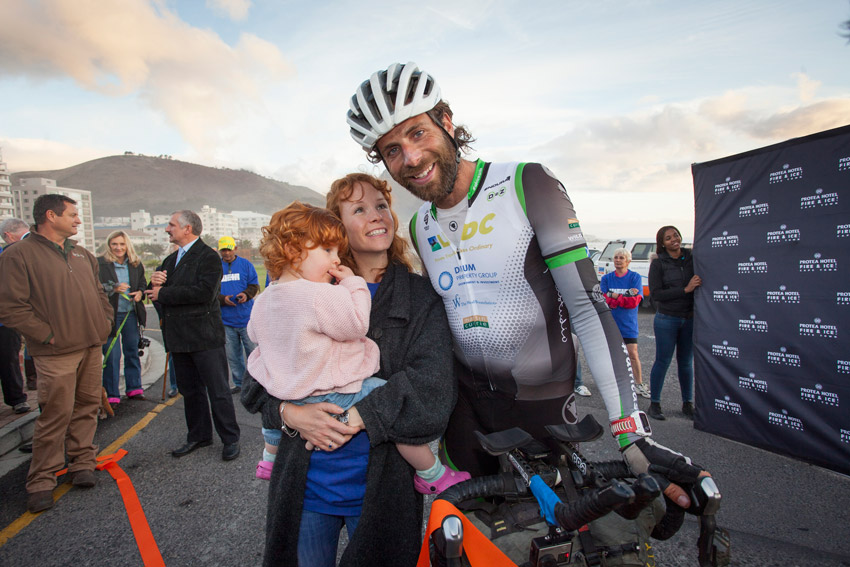
Mark Beaumont with his wife and daughter at the finish line of the Cairo to Cape Town route. (Photo courtesy of Mark Beaumont)
In 2014, I presented the buildup to the Commonwealth Games in Glasgow for the BBC by visiting and filming the 18 Commonwealth countries in Africa. This was a journey that I absolutely loved and decided to come back the year later and cycle the length—and complete this bucket list hat-trick of epic rides.
Andolfo: When I first started touring on my bike, I knew I was not yet ready for Africa due to a lack of experience because it was not the easiest place on a bicycle. While planning my travel across the world, it was definitely on my list. But, my journey wouldn’t start there.
However, after cycling from France to Vietnam and North America over a span of 17 months, I said to myself, “Now I’m ready to do it.”
Eilidh: It was during the Covid-19 pandemic lockdown that I realized I needed to challenge myself more and had to go on an adventure. In my opinion, I don’t think there’s a bigger expedition than cycling a whole continent, especially one as vast and majestic as Africa.
Emilie: I am on a mission to travel the world on a bicycle. But, I am doing it slowly.
Tristan: I was already cycling around the world and had always planned to cycle through Africa, but it’s also probably the most unique continent, so there was no way I was going to miss it.
Q: What does a day of biking in Africa look like for you?
Mark: Whilst I was trying to beat the Guinness World Record for Cairo to Cape Town and therefore cycling on average 160 miles a day because I was solo and mostly unsupported, the biggest part of each day for me was about finding my next meal, a safe place to sleep each night and navigating the route. I did not stop to be a tourist, but I was constantly enjoying the passing world around me and the people I met. I never camped, even though I was carrying a tent in case I needed to. So each night I would be in towns, villages, truck stops, or wherever I could find a bed—and each day I would cycle pretty consistently between 6 am and 6 pm—you need to be careful, as it gets dark very fast!
…the biggest part of each day for me was about finding my next meal, a safe place to sleep each night and navigating the route. Mark Beaumont
Andolfo: I slept in a tent almost every day and would be woken up by the beautiful sunrise and the birds tweeting—I didn’t need to set an alarm. I would then stretch my body as I prepared for a new day and have a simple but healthy and filling breakfast.
After, I would start riding and set off in the wild but would only cycle around six to seven hours as I wasn’t concerned about the distance, but would take other factors into consideration. If I found a breathtaking spot or met some interesting people, my plans changed and I would start all over again on the following day.
Eilidh: I tried to wake up early because of the sunrise and tried to start cycling between 7 am and 8 am. Around 10 am or 11 am, I would take a snack break and stop for lunch at about 1 pm or 2 pm—sometimes when I found a nice place to eat.
Depending on where I was heading, I would retire for the day between 3 pm and 5 pm, have my supper then tend to other things. Unless wild camping, I’d take two showers daily—one in the morning and another in the evening. I used my breaks to refill my water bottles and put on more sunscreen to stop my skin from burning in the hot African sun.
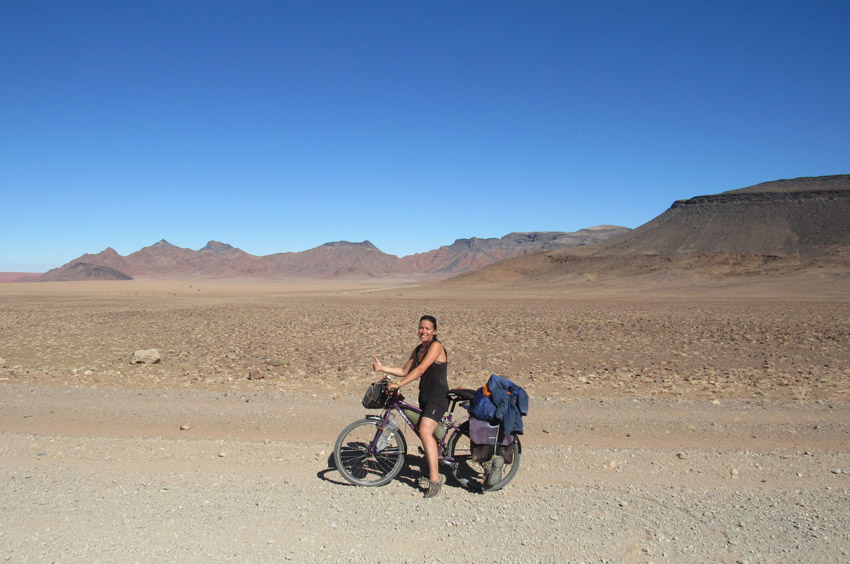
Emilie somewhere deep in the Namibian desert. (Photo courtesy of Emilie Poudroux)
Emilie: Starting early, after sunrise, I cycled slowly but often stopped in villages to meet people, visit places, find food, and learn more about the villagers and their way of life. My goal wasn’t to cycle as much as I can but just to enjoy the countryside and the amazing people I met along the way.
Tristan: It depends on which part of Africa I was in; the daily experience was very different in Egypt than what it would be in Sudan, Ethiopia, East Africa, or Southern Africa. But generally, my daily routine was the same in Africa as it is anywhere else in the world. Wake up, pack up the tent and load the bike, then cycle, eat, drink, see beautiful things, meet interesting people, sweat, resupply, rest, and repeat. Life is very simple when crossing a continent on a bicycle.
Q: How difficult is it to cycle in Africa?
Mark: In 2015, there were still sections of a dirt road in southern Ethiopia and northern Kenya, whereas I believe there is now an unbroken ribbon of tarmac the entire length of this route. This section was difficult, especially with the mud after heavy rains—but now it should be much easier. The roads in Egypt are pretty good, and the main challenge is getting space from the local police, who like to escort cyclists, which some people might like, but I found unnecessary and a tad annoying.
In Sudan, the roads through the Sahara desert are superb and you normally get a helpful wind from the north. Into Ethiopia and you have the toughest cycling of the entire route through the north (the Highlands) with amazing views, but very tough roads. Everyone talks about the Blue Nile Gorge, which is spectacular, and a very long climb indeed—but this is in the south and comes in an area that is much flatter south of Khartoum.
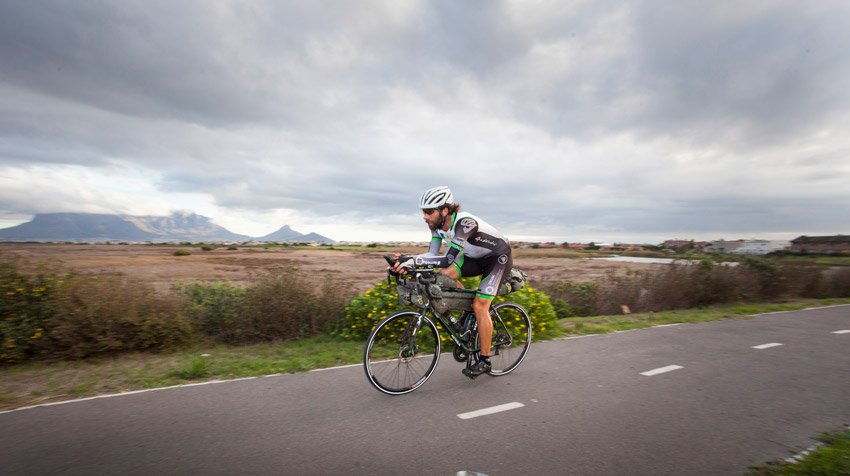
Mark racing his way through Africa attempting to break the world record. (Photo courtesy of Mark Beaumont)
Further south, the route goes through some great farmlands and savannahs in Kenya, Tanzania, and Zambia. Northern Kenya is pretty sparse, so carrying enough supplies in this section is important. Back in 2015, there were also some security concerns here, so I had local police with me until Archers Post. This situation might have changed now. The best wildlife on the route is in northern Botswana in areas south of the Zambezi river. There are elephants on the road, which can be pretty intimidating, so try not to get caught out here late in the day. Into South Africa, the Great Karoo is a semi-desert plateau, which seems endless as you make your way to the West Cape, finally dropping into an area of vineyards and the coastal ridge before Cape Town. Overall, I felt very safe cycling the length of Africa and was always met with kindness and generosity from the people I met.
The best wildlife on the route is in northern Botswana in areas south of the Zambezi river. Mark Beaumont
Andolfo: The level of difficulty depends on the country you are riding across. In Namibia, for example, I felt lonely and was under the impression that I am the only person on Earth—but this was nice and I felt grounded and at one with nature. To have an understanding of how alone I was, this was the first country I cycled listening to audiobooks all day!
Crossing a whole country for weeks, all alone in the desert with a powerful headwind and scorching hot sun, isn’t easy, but we do it because we love it. This is the meaning of pure adventure!
Eilidh: The main difficulties I faced were sunburns and the humidity—especially in Tanzania. Generally, the more time you have, the easier it is. My recommendation is when you have time, you should stop early and chill out and find the nicest places to stay. Everything is possible when you have time, and usually, things would come together—often at the last minute. But, if you’ve got a long way to go, you might have to pay more or find accommodation that is basic.
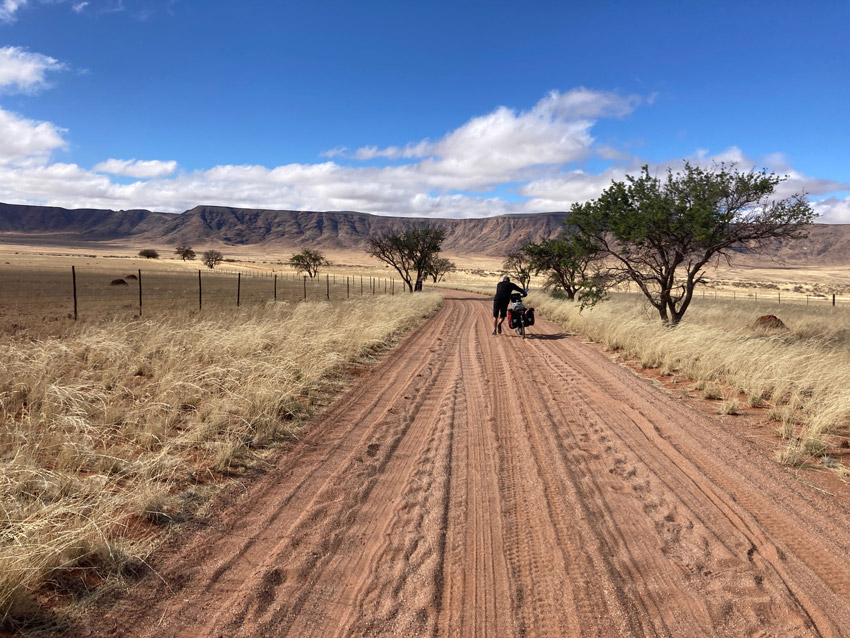
Cycling in Africa in especially hard on sandy roads; most cyclists end up pushing their bikes on these sections. (Photo courtesy of Eilidh Ogden)
Emilie: It’s actually easier than you’d think! The main challenge, however, is the heavy traffic and the speed of some cars and trucks on the road. I found it easier to choose less traveled roads to cycle on. The heat is also a bit annoying, especially in Sudan and Zambia during the hot season as the temperatures rise to unbearable levels.
As I did not train at all before leaving Europe, cycling through some mountainous areas of Ethiopia or the sandy roads of Sudan and Turkana was strenuous for me, but I am glad I did it!
Tristan: I would say it’s probably slightly harder than cycling through more developed continents like Europe, as you need to do a bit more planning for things like repairs, resupply, visas, etc. But overall it’s fine because cycling across any continent isn’t easy and I have to say that Africa isn’t miles ahead in difficulty rating.
Q: Is Africa dangerous for bicycle tourists?
Mark: I found Africa to be a wonderfully interesting and welcoming continent to cycle. Like anywhere you need to be street-wise and watch your bike and equipment. But a lot of the concerns that I had before I left were unfounded. I remember journalists asking me questions about whether I was afraid of lion attacks or terrorists—these questions seem pretty naïve and cliché having cycled in Africa. I had a better welcome from strangers than any other continent that I cycled across.
Andolfo: Talking from my experience, Africa isn’t dangerous but like anywhere else in the world, of course, you have to be careful. I never once locked my bicycle in Africa for the 2 years I was there because I was very comfortable. The only time I felt unsafe was when cycling on busy highways in traffic.
For instance, in Europe, the countryside is safer than the bigger cities, so you organize your stay accordingly. By the rule of thumb, I wild camp in the less populated areas and prefer Couchsurfing, hostels, and Warmshowers in crowded and less safe areas.
I never once locked my bicycle in Africa for the 2 years I was there because I was very comfortable. Andolfo Aldo
Eilidh: I found Africa to be safe in general even though I cycled as a solo female. The roads, however, can get dangerous, particularly on the way into and out of the big cities and major towns. To be safe at night, I didn’t cycle around and tried to stay out of risky situations. For example, I tried to make sure I only camped where people wouldn’t find me, especially in the dark.
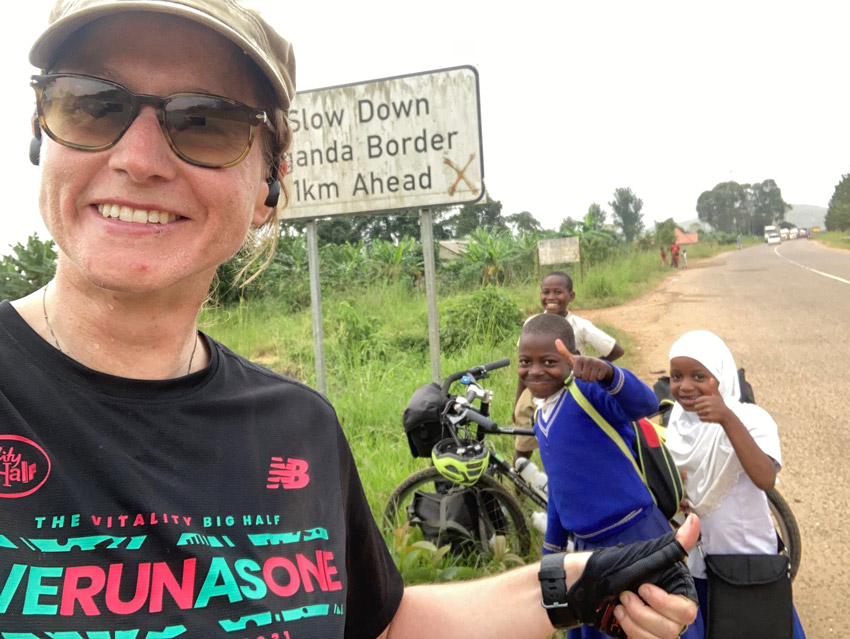
Eilidh with curious African kids before the Ugandan border. (Photo courtesy of Eilidh Ogden)
Emilie: I would say it isn’t dangerous if you pick your route carefully. My sincere advice is to avoid roads with heavy traffic to reduce the chances of an accident. People in Africa don’t obey road laws and drive like maniacs.
Tristan: It depends on where you go since Africa is a big place—In a country like Somalia yes but in Sudan no. Generally, I don’t think it’s much more dangerous than anywhere else as long as you’re sensible and exercise common sense.
Q: What has been the best about the Cairo to Cape Town route for you?
Mark: It is hard to choose my favorite parts of the route, but if I had to, then I would go back to northern Sudan, staying at truck stops and riding that amazing desert road, or the elephant highway in northern Botswana, remembering back to a moment when a giraffe was cantering alongside me.
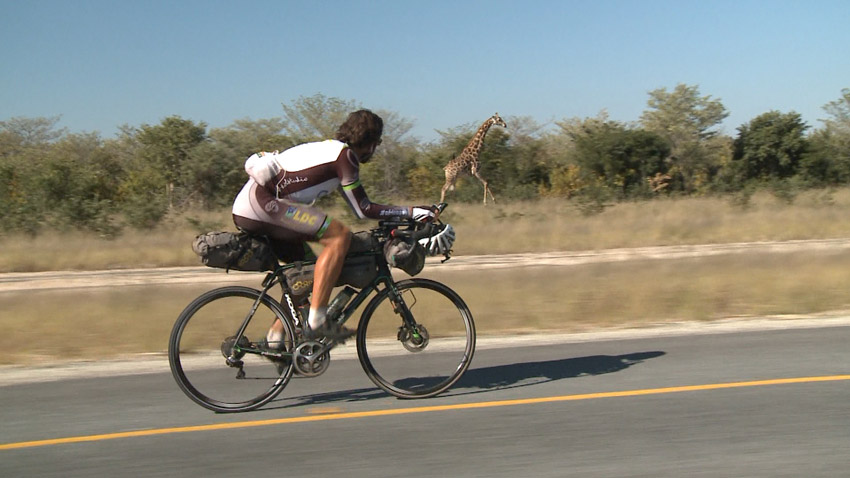
Talk about the perfect shot: Mark racing a giraffe in Botswana. (Photo courtesy of Mark Beaumont)
Andolfo: I don’t like to compare my memories or talk about which ones I like more, since every moment’s unique. It all depended on my mood and whether I wanted to explore the country in detail or not. Also, when I greeted people in their local dialect, it struck a deeper connection. However, I have had some unforgettable experiences in Africa with wildlife. For example, I crossed a national park and was surrounded by zebras, giraffes, antelopes, monkeys, and other wildlife—this to me is what is unique to Africa.
In Morocco, I wrote an article named, “Recreate New Memories” to explain how my extraordinary life turned into the norm after spending years on the road. Every day I encountered amazing people, experienced special things, and saw some breathtaking landscapes. When you stop comparing, you learn a valuable lesson: “Live in the moment and see how the world is a gift to us.”
Eilidh: I loved how things would always work out in strange and mysterious ways! Often when I had problems like finding a place to stay or having a damaged bike part, someone would suddenly appear out of the blue and offer to help.
For example, in Zambia, I was running out of cash and didn’t have enough to pay for accommodation that night, but some strangers stopped to talk to me and I asked them where the nearest cash machine was. Instead of pointing me in the right direction, they just gave me money and asked me just to pay it forward!
I loved how things would always work out in strange and mysterious ways! Eilidh Ogden
Or when my wheel hub broke in the Namibian desert and I was stranded, some local farmers put out a call and I ended up getting a replacement flown into a lodge by private plane and it arrived at the campsite before me.
Emilie: The best thing so far for me has been the ability to use only the power of my legs to take me across Africa. I had an amazing experience in very remote areas—especially in the areas of Turkana and Sudan where I stayed in villages.
Tristan: There are far too many highlights for me to narrow down to. Crossing the Sahara is incredible, while Kenya is a jewel, and visiting all the historic temples in Egypt leaves an unforgettable experience. After finally making it through Ethiopia, I felt like I won the lottery. The endless wide open spaces of Botswana and Namibia—it’s impossible to choose!
Q: What has been the most challenging part of biking in Africa for you?
Mark: Ethiopia is by far the hardest country on the route, in terms of the climbing, the road quality, the food, and also the culture—it was the only part of the ride where I felt crowded and at times concerned for safety. I had no incidents, so any worries came to nothing, but when I passed through villages in the north, I did have kids throw stones at me, and when I stopped I did attract some crowds—which didn’t happen anywhere else.
Andolfo: My most challenging leg of the journey was cycling in South Africa, where I was forced to ride and sleep under the rain and was wet all day and night. I may exaggerate a bit, but it was very difficult. To add to this were the mountains and dirt roads that drove me crazy, but I must say, it’s an amazing country. Sometimes you suffer, but the reward, in the end, is worth the pain.
Eilidh: My biggest challenge in Africa was people being very friendly and wanting to have a conversation with me all the time. Having lived in London for 10 years, I am used to a place where you don’t talk to people or make eye contact. It can be a bit intense having lots of people wanting to greet you and talk to you!
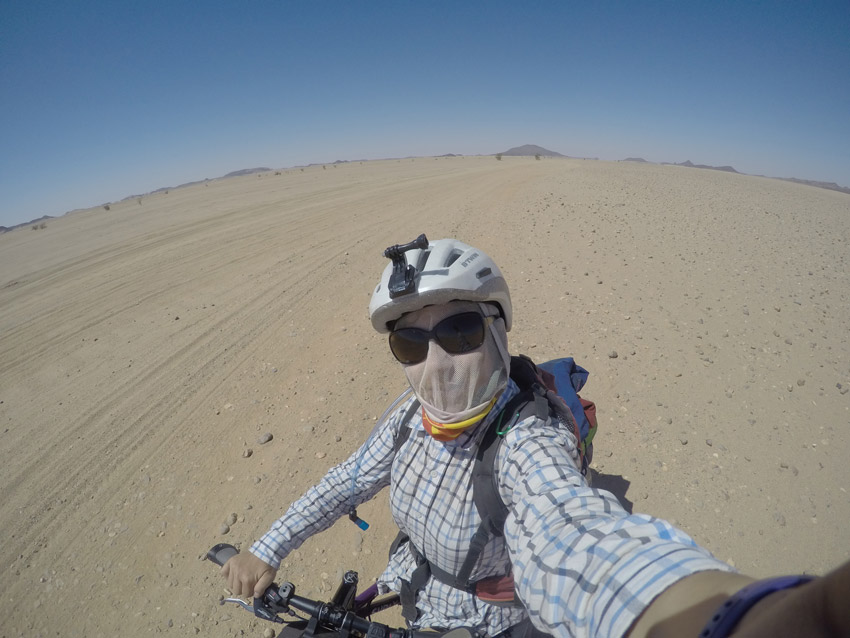
Battling scorching hot temperatures and sand in the Sudanese desert. (Photo courtesy of Emilie Poudroux)
Emilie: The most challenging bit I found about Africa was cycling in Ethiopia. This is one place where I couldn’t communicate because of a language barrier. The food wasn’t to my liking, and I encountered many beggars haggling around me. Though I must admit the country is spectacular and the people were amazing.
Tristan: Without a shadow of a doubt, Ethiopia was the most challenging. But, I’m glad I cycled through because it was an experience that I’ll always remember. It’s a beautiful country, full of lovely places and nice people. However, the general population (especially the children) was incredibly hard at work with all their endless hassling, highly aggressive behavior, and annoying stone-throwing— this is the reason cycling in Ethiopia is notorious in bike touring circles, which is a shame.
Q: What kind of bike did you choose for this trip and why?
Mark: I rode a Koga Kimera carbon road bike with Di2 Shimano Ultegra gears. I was packed with Apidura bike packing bags. My choice was around going light and fast for the record. There was a lot about this bike that I couldn’t fix on the road, so I was opting for reliability.
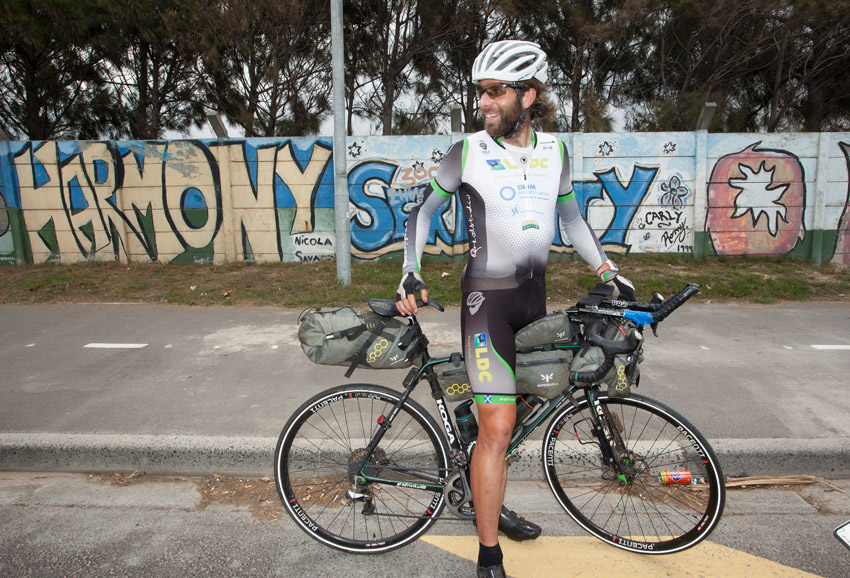
Mark with his Koga Kimera road bike in South Africa. (Photo courtesy of Mark Beaumont)
Andolfo: I am bikepacking with a touring bike called “HISTOIRE” which is manufactured in France. It has a fairly simple design and build with basic mechanics and is easy to fix. This, according to me, is what’s needed on the ruthless African roads.
Eilidh: I own a Thorn Nomad, which is one of the strongest and most reliable touring bikes available today. Though I bought mine off eBay and it’s very old and battered—I figured, I wouldn’t have to worry about scratches and minor dents. She has amazing 26-inch wheels and a dynamo, which I think is the perfect combo for cycling in Africa.
Emilie: I decided to bikepack across Africa on a Surly Troll purely because it’s a strong bike and some of my friends that use it recommended it to me.
Tristan: I was riding a Surly ECR with massive 29+ tires because I prefer to go off-road when possible and I find it usually leads me to more interesting, remote, and beautiful places. If I do go back, I’d ride a rigid mountain bike with something like 2-2.3” tires for most of it. There was a lot more pavement to ride on than I’d expected, therefore having faster tires would have made my life easier. However, there’s enough gnarly off-road available that I wouldn’t want to cycle on a gravel bike either.
Q: What are some essential pieces of kit you recommend bringing aside from the obvious?
Mark: Plenty of spare patches for punctures, especially in Ethiopia where you get thorns from bushes on the road—which are as sharp as needles. Choose tires with decent side walls because you won’t pick up suitable replacements for the northern half of the route.
Plenty of spare patches for punctures, especially in Ethiopia where you get thorns from bushes on the road—which are as sharp as needles. Mark Beaumont
Andolfo: I recommend carrying at most two extra tires as I did 18,000 km on only two tires—I prefer either Schwalbe Marathon Mondial or Marathon Plus. All you need is one extra chain, tubes, patches, multi-tools, chain oil, spokes, a pump, and an extra set of pedals because it’s close to impossible to find good ones in most African countries.
Eilidh: My Ortlieb 10L water bag was invaluable and a lifesaver. The titanium spokes I had on the rims are perhaps the best purchase I have made in my life! I also have a dynamo hub that charges my devices via USB—I love that.
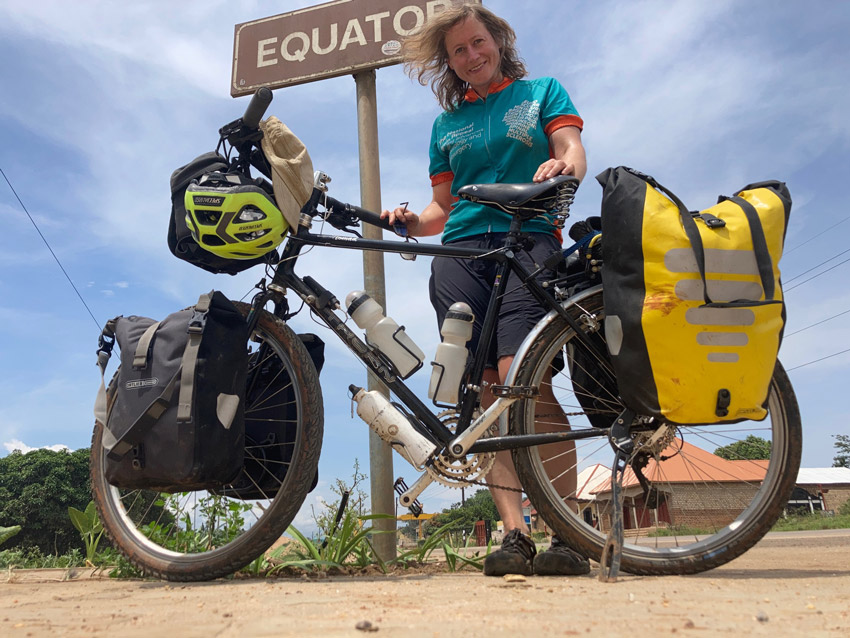
Eilidh with her Thorn Nomad bike equipped with Ortlieb front and rear panniers at the Equator. (Photo courtesy of Eilidh Ogden)
Emilie: I recommend carrying a spare chain, patches, and extra tires—I use the Schwalbe Marathon Plus which I cannot find in Africa.
Tristan: To avoid buying bottled water which increases your expenses and plastic usage, I recommend purchasing a water filter which some may say is obvious but is worth mentioning—it’s incredibly useful in Africa. I also suggest bringing a freestanding tent due to the multiple terrains where pitching a tent may be impossible. Often you will encounter sand or hard ground and concrete that make camping difficult.
I highly recommend not to skimp out cold weather gear as some countries in Africa get cold too—depending on the time of year you ride through.
Q: Were there any pieces of kit you brought but didn’t find much use for?
Mark: I didn’t use my tent, as I always found an inhabitance to stay in—whether that was a tiny truck stop or a big city. However, if I would do the trip again, I would still carry a tent for emergency use. This comes in handy, especially if you got caught out in the bush at night.
Andolfo: I only carried the most essential tools and found a use for all.
Eilidh: A she-wee—it’s a funnel women can use to pee standing up and without undressing. I used it in my tent only once when I was camping in a classroom and didn’t know where the toilet was.
Emilie: I ended up using all the pieces of kit I took along with me.
Tristan: Nothing really because I pack very light, so don’t really have anything except the essentials.
Q: Were you wild camping? Is wild camping in Africa easy?
Mark: I have wild camped in Kenya previously, but not on this trip. So I don’t have a lot of experience as I always wanted a big meal and a solid night’s sleep. I, therefore, tried to push on each night till I reached a community where I could get a shut-eye.
Andolfo: I was wild camping most of the time and found it easy to do so except closer to the cities. In some countries, you can ask the villagers to camp in their compound—they are always happy and curious to receive you. It was a good way for me to share some really good moments with the locals.
I was wild camping most of the time and found it easy to do so except closer to the cities. Andolfo Aldo
Eilidh: I did some wild camping, particularly in Namibia and Sudan. As a woman, I generally believe everyone or no one should know you’re there.
In most of East Africa, accommodation was very cheap so, when you’re tired, it was easiest just to pay a few dollars rather than ask someone and be their guest. I can be quite unsociable when I’m tired and like to have my own space.
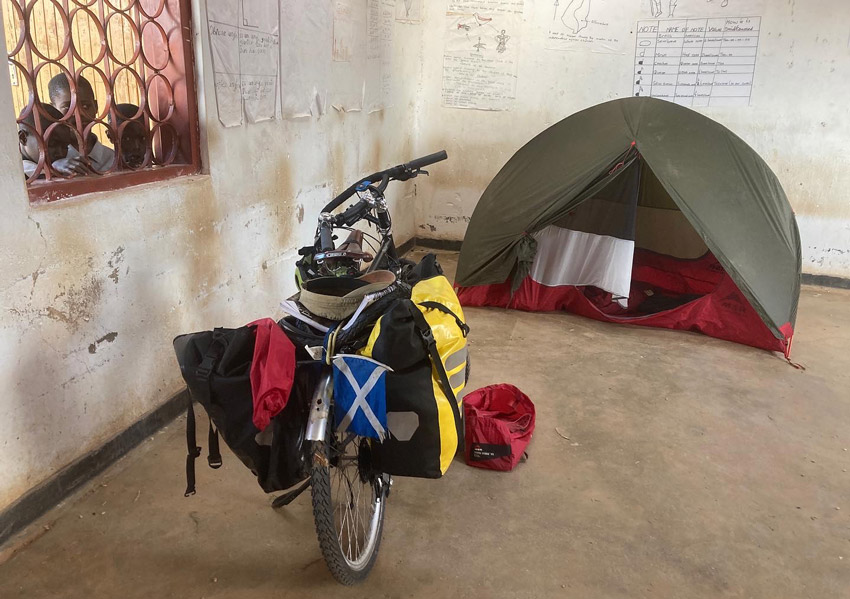
Eilidh’s camping spot in an African school. (Photo courtesy of Eilidh Ogden)
Emilie: Yes, I like to wild camp as much as I can. Wild camping is sometimes challenging, especially during the rainy season as some areas were flooded. I experienced this in Zambia and Botswana. Also, some areas have a lot of wildlife, so my advice is to ask local people before getting into any trouble.
In areas that are heavily populated, I didn’t feel too safe as a woman all on my own so chose to camp in places like villages, police stations, schools, and restaurants, especially if it wasn’t possible to set up my tent elsewhere.
Tristan: Yes! I wild-camped throughout my trip across Africa. Again, it depends on where. In the Sudanese Sahara, and down in Botswana and Namibia, wild camping is incredibly easy as there’s so much empty space, whereas, in Ethiopia where the population density is incredibly high, it’s very difficult. It’s always possible, though, even in Ethiopia, although I often had to wait until dark to pitch my tent and then make sure I was packed up and gone by sunrise so no one would see me. I very much recommend the free app iOverlander for helping find wild camping spots, it’s a fantastic resource.
Q: What wildlife have you spotted throughout Africa?
Mark: Wildlife is not as prevalent as you would think. The big game is only in small areas these days, and I didn’t see any till I reached Botswana. There is plenty of bird life, lots of dogs, the odd camel in the north, and farm animals throughout. But you will do well to spot a lion or elephant for most of the ride.
Andolfo: In Africa, wildlife will always surround you, especially if you cycle through or camp in a national park. Though I was very lucky at night and didn’t encounter any animals. But, I did see some dangerous animals during the day. When night fell, I occasionally heard some hippos and elephants.
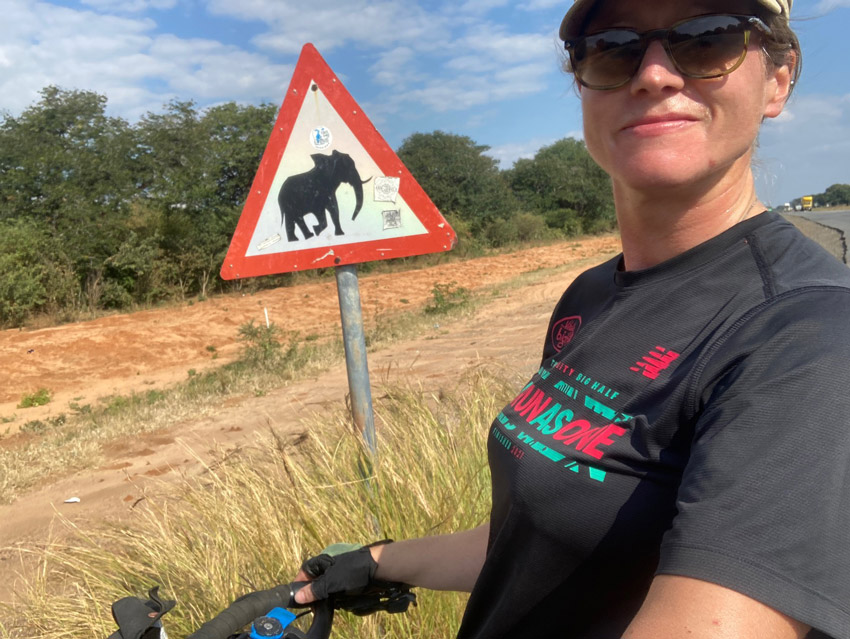
Elephants on the road! An unlikely road sign in the rest of the world. (Photo courtesy of Eilidh Ogden)
Eilidh: You spot a lot of wildlife in Africa! Once I was chased by an elephant in Botswana. After that, I always used a car as a buffer. Except for the same day when I stayed at ‘Elephant Sands’, which has elephants wandering about everywhere. I also spotted crocodiles, zebras, giraffes, oryxes, and many incredible birds.
Emilie: Yes! I have spotted a lot of wildlife on my journey—like hyenas in Ethiopia, lions in Southern Tanzania (close to the road from Dar to Mbeya), zebras and antelopes in Kenya, and a lot of elephants in Botswana!
Tristan: I encountered loads in East Africa, plus quite a bit in Botswana as well. From the saddle, I’ve seen zebras, giraffes, antelopes, baboons, monkeys, ostriches, elephants, warthogs, eagles, hyenas, and buffalos. And off the bike, I’ve also seen hippos, crocodiles, lions, and leopards. The only big animal I’m yet to see in Africa is a rhino.
Q: What advice do you have for cyclists planning to do the Cairo to Cape Town by bike?
Mark: Go for it! Cycling from Cairo to Cape Town is in my opinion the best bike ride on the planet. Fear of the unknown is what often puts people off. If you don’t want to go alone then Tour D’Afrique does a fantastic supported expedition along the route. I have friends who have done this, which has the advantage of not having to carry your own kit.
Andolfo: Don’t listen to people who judge Africa to be a dangerous place when most of them have never been there. If you dream about Africa or any continent by bicycle, just run after it and don’t think too much or it will be too late. Life is short!
Eilidh: Yes! Just do it! Why waste the opportunity if you have it?
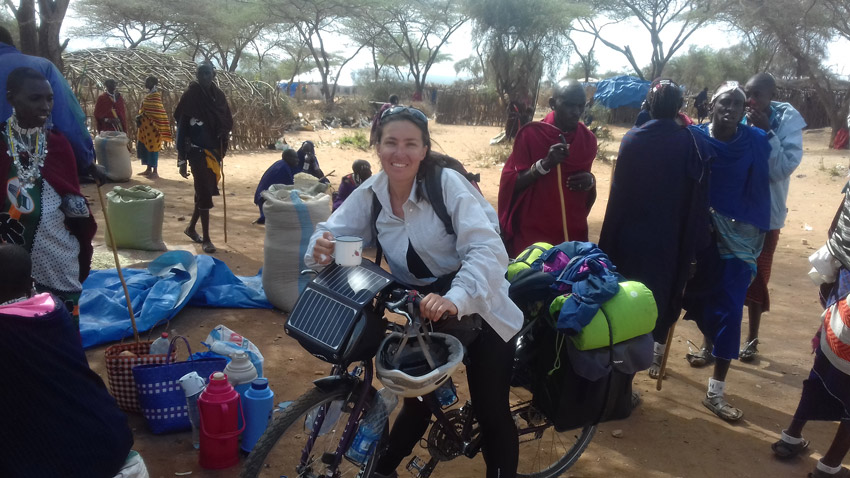
Taking a well-deserved break with the Maasai tribe in Tanzania. (Photo courtesy of Emilie Poudroux)
Emilie: Yes sure. I recommend everyone should dare it, even if you are a solo woman or not super fit! Look at me, I did it!
Tristan: Definitely! It’s an experience you’ll never forget. You shall learn more about yourself and the world in a year of cycling through Africa. This is by far over what you ever could in a year spent working 9-5 at home. So why not do it? What is stopping you?
Q: What Airline did you fly with your bike and how was your experience?
Mark: I can’t remember who my carrier was, but flying from the UK to Cairo and back from Cape Town is pretty easy—especially as there isn’t much of a time zone change. As you are flying in and out of a different location, I normally just fly my bike in a cardboard box which is packed out really well to protect the frame. This means you can simply dispose of it, rather than worrying about what to do with an expensive bike box.
…Flying from the UK to Cairo and back from Cape Town is pretty easy—especially as there isn’t much of a time zone change. Mark Beaumont
Andolfo: I didn’t fly to Africa with my bicycle. My journey started off cycling from France and when I ended my tour in Malawi—where I gave away my bike to a friend. I bikepacked over 50,000 km around the world on it and was about time to let go of it, but I know it has a second life somewhere in Africa.
Eilidh: I used British Airways to fly into Egypt and out of South Africa and they are good at flying with a bike. From Khartoum to Nairobi Kenya Airways to fly—I wouldn’t recommend them. Their website says that they include bicycles as part of your luggage, but at the airport, they didn’t let me fly unless I paid $50 more in cash. This is the first and last time I will fly with them.
Emilie: I flew Egypt Air to Cairo and took Emirates from Cape Town to return home. Personally, both were good experiences, but I recommend packing your bike well in a big box to avoid damage during transit.
Tristan: I entered Africa in Egypt via ferry from the Middle East and I flew out of Cape Town to Brazil. I remember not having any issues with flying my bike, but I can’t recall the name of the airline.
Q: What was your border crossing experience like?
Mark: Most of the borders are pretty straight forwards, especially in the southern half of the route—from Kenya onwards. I had some local help to get me across the border from Egypt to Sudan, but back then the road along Lake Aswan had only just opened up—before that you had to get a boat. However, it might be easier now that times have changed.
The only border crossing you need to be a bit careful on, in my opinion, is Moyale, crossing from Ethiopia into Kenya—there are a lot of people trying to change money for you, sell you things, and a feeling where you could be conned. My advice would always be to get through borders and clear the next 10km as quickly as possible—don’t linger, go to restaurants or stay in hotels right on the borders unless you have to.
Andolfo: Crossing borders in Africa is always special because some are so simple that you can’t tell it’s a border. In some places, all you find is a cabin with a small gate and customs officers laughing at the fact that you are on a bicycle and think that you are crazy. While crossing the Ivory Coast border, one officer asked me, “Why are you hurting yourself like that?” I had no response—but it was funny at the time.
Crossing borders in Africa is always special because some are so simple that you can’t tell it’s a border. Andolfo Aldo
On this one occasion in Brazzaville Congo, a customs representative hosted me inside his office and also invited me out for dinner. It’s strange to cross a border and not know what to expect out of it. Visas, on the other hand, are more difficult to attain in Africa than in Asia—some visas need to be obtained in advance from the embassy in your country as they aren’t available on arrival.
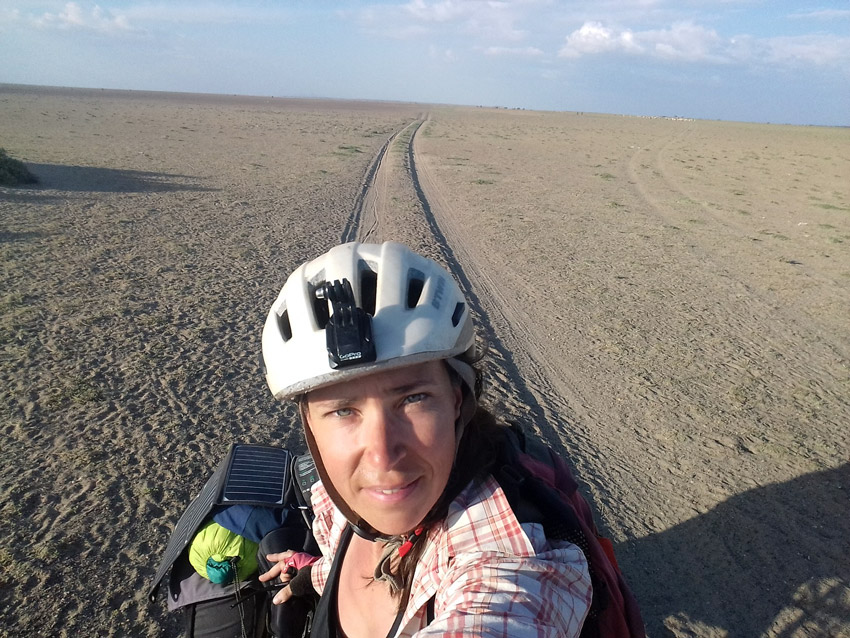
Emilie in the African desert, on a border between Ethiopia and Kenya. (Photo courtesy of Emilie Poudroux)
Eilidh: Most border crossings were trouble-free, and I crossed without any issues, even during the Covid-19 pandemic and having to get PCR tests. Being a solo female traveled was definitely an advantage to me. There’s a Cairo to Cape WhatsApp group which was invaluable for sharing information about border crossings, and there is also an app called i-Overlander where people share real-time updates on the circumstances.
Emilie: My overall experience at all the borders was very good—having not paid any bribes or been hassled by immigration officers. It surprised me when no one bothered searching through my bike or checking my belongings.
Tristan: My general experience in most countries was fine, but I came across very unhelpful officials while entering Zimbabwe. However, I’m British, so this inhospitable behavior doesn’t come as a surprise.
Q: How did you go about fixing your bike and getting spares?
Mark: Spares can be difficult to get hold of in Africa—especially for modern US or European bikes. I sent small packages to myself in Addis Ababa, Nairobi, and Zambia. Thanks to the arrangement, I would have fresh tires and chains to put on. You can swap your front and back tires to make them last longer—as the back wears faster.
Andolfo: If you prepare for eventualities in advance, as I mentioned earlier, you will be fine. In bigger cities and towns, you might be lucky to find most of the components such as spokes, tires, tubes, oil, and much more, but the quality isn’t guaranteed.
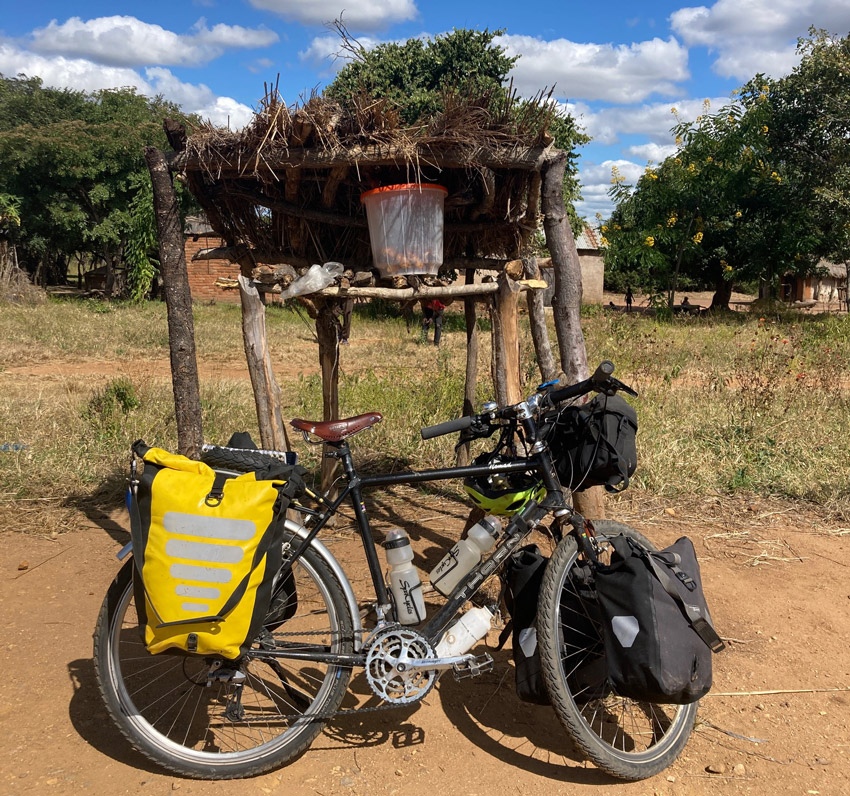
Eilidh’s fully-equipped Thorn Nomad touring bike with a spare Schwalbe Marathon tire on the rear rack. (Photo courtesy of Eilidh Ogden)
Eilidh: I brought tools with me and watched YouTube videos where I wasn’t sure. I also took spares with me too—but I’d recommend using Schwalbe Marathon Plus Tour tires to minimize your punctures (I had 5 in 6 months—most in Malawi). In most of the countries I visited, people had bikes but without gears, so any gear-related issue is a nightmare to fix due to a lack of parts and experts.
Emilie: Fortunately I was able to repair my own bike, but I did get assistance occasionally. For example, in Malawi, I sourced a replacement for my broken spokes and in Namibia I visited a local bike shop to replace my pedals.
Tristan: Simple parts are generally obtainable in bigger cities, but the availability of parts is definitely one of the challenges in Africa. Plan ahead and be organized because sometimes you do have to order for parts to be shipped ahead for you to collect en route. Tip: Be ready to improvise.
Q: How did you plan your trip and route?
Mark: The record for Cairo to Cape Town has fixed start and end points—which are Cairo Tower and the waterfront in Cape Town—I chose Moullie Point. You can take whatever route you wish, but to go fast, there is really only one obvious way. I did research based on what others have done and my route has been used by many since. There are small changes, for example, a more direct route through the middle of Zambia, but most of it is the same. Some people carry on south from Livingston as an alternative to heading west for a bit and crossing into Botswana.
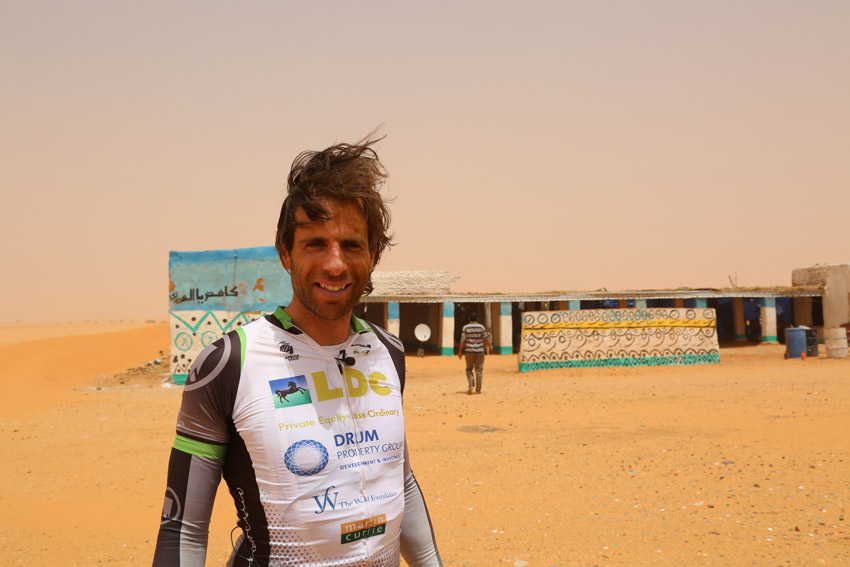
Heat, wind, sand, desolate deserts, and a massive smile. (Photo courtesy of Mark Beaumont)
Andolfo: Before arriving in a country, I would do some research on places of interest and spots to rest and add to my GPS app, Maps.me. On arrival, I would create my own route and let the adventure unfold.
Eilidh: I read a lot and researched many blogs, but I did have a rough idea of the visas I needed and the process to attain them. I joined the WhatsApp group where I asked people questions and was overwhelmed by the response. I did generally plan my route as I went along, but the biggest decision I faced was whether to stick to the East or head West towards Namibia—I detoured West and it was awesome!
I joined the WhatsApp group where I asked people questions and was overwhelmed by the response. Eilidh Ogden
Emilie: I am a professional tour guide so I used my knowledge of Africa to plan the perfect trip.
Tristan: Cairo to Cape Town was the rough plan and from there you are limited in which countries you can cycle through because of safety and visa considerations—planning is fairly simple. Beyond that, I just planned country by country by looking through maps, existing routes online, and local knowledge.
Q: Are there any special groups where you communicate?
Mark: None that I used, except for the team at Tour d’Afrique—who, I must say were very helpful in my planning.
Andolfo: I have a few friends that have previously cycled the route and were very instrumental in helping me plan. I am in a Cairo-Capetown bikepacking group where members share information but because I don’t like organizing myself too much, I just went with the flow. However, I use my blog and Facebook groups to communicate with others regarding my journey.
Eilidh: There’s a Cairo to Cape Town Cycle WhatsApp group which was really helpful, especially during Covid for getting border advice and knowing the travel restrictions in every country.
Emilie: Yes, I used a WhatsApp group to share information and my experiences, but it was not yet created when I cycled Africa. I used Instagram as a means to meet other cyclists and found a few that have cycled a route similar to mine.
Tristan: There was a WhatsApp group for cycle tourers in Africa riding Cairo to Cape Town, which was a great source of information and not to mention a fun way to share experiences while linking up with other cyclists along the way. I left the group after I reached Cape Town in order to clear a spot for new cyclists, but I believe the group is still going and I’d really recommend finding it and joining. If you don’t find a group, this is your chance to make one.
Q: What kind of accommodation did you use and how did you search for it?
Mark: I simply found accommodation each evening as I went. Apart from my first few days in Egypt, which had to be booked to get my tourist visa, I found accommodation as I went. I never had to ask a second person for a place to eat or sleep for the entire 10,000km route—which is a level of friendliness and welcome that I have not experienced in other continents.
Andolfo: For finding accommodation, I mostly use offline maps to see if there was a guesthouse, hotel, or campsite nearby. I am also a member of communities like Warmshowers and Couchsurfing, which I found very useful. There’s an app called iOverlander that I recommend very much and find helpful while searching for a spot.
There’s an app called iOverlander that I recommend very much and find helpful while searching for a [camping] spot. Andolfo Aldo
Eilidh: I used lots of small guesthouses—often that I found on the i-overlander app. In Sudan, Namibia, and Botswana I camped a lot, but sometimes I’d ask people if I could camp at their place and they’d happily offer to give me a room.
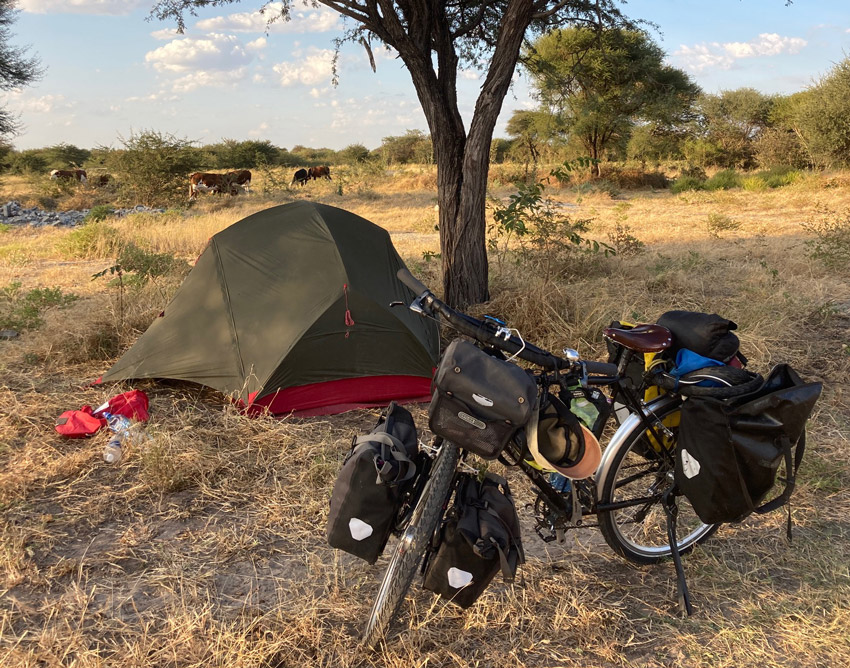
Wild camping spots are easy to find throughout most of Africa. (Photo courtesy of Eilidh Ogden)
Emilie: Most of the time I preferred to wild camp, but occasionally I spend the night in churches, schools, and villages along the way. Sometimes I used the iOverlander app and stayed in local hotels after speaking with locals and getting recommendations.
Tristan: I was mostly wild camping but sometimes stayed with locals and paid for accommodation or camped at lodges. iOverlander is gold for this—it’s full of good information. Throughout most of Africa, you can also ask to camp at police stations for the night and they will generally be happy to have you. In southern Africa, in particular, we did this a LOT.
Q: Finally, would you recommend people to follow in your steps and give biking in Africa a shot?
Mark: Absolutely! I highly recommend this to anyone planning to bikepack Africa.
Andolfo: Yes I do, but it’s too long a journey to break down into basic steps. But do follow what I have said and you should be fine. Eventually, everyone must live their own lives and have their own adventures.
Eilidh: Yes! Just do it!
Emilie: Yeah, sure! I highly recommend everyone to dare it—even if they are a solo woman or not in the best physical shape. I did it!
Tristan: Definitely! It’s an experience you’ll never forget and you get to learn more about yourself and the world in a year of cycling through Africa than you ever could in a year spent working 9-5 at home. So why not?
Online resources recommended throughout this interview for the Cairo to Cape Town trip:
- iOverlander: An indispensable app for any long-distance trip offering a database of places for travelers that includes camping, hotels, restaurants, mechanics, water sources, and more.
- Cairo to Cape WhatsApp group: The official WhatsApp group for anyone interested in doing the Cairo to Cape Town cycle route.
- The Cairo to Cape Cycle Club Facebook group: The official Facebook group for anyone interested in doing the Cairo to Cape Town cycle route.
- Warmshowers: An amazing app that lets you find hosts offering free accommodation for bicycle travelers around the world.
- Couchsurfing: An amazing app that lets you find hosts offering free accommodation for travelers around the world.
- Maps.me: Maps.me is a mobile app for Android and iOS that provides offline maps using OpenStreetMap data.
- Tour d’Afrique: Supported Cairo to Cape Town cycling expedition organized by TDA Global Cycling.

